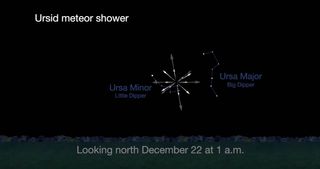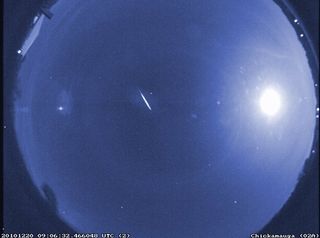Ursid Meteor Shower 2019: When, Where & How to See It
By Elizabeth Howell
Space.com
The Ursids produce a handful of meteors or shooting stars every hour, usually in the range of five to 10 per hour. A nearly moonless sky means good viewing, despite the low.
The 2019 Ursid meteor shower will peak overnight the night of Dec. 21-22.
In some past years, the meteors have been more spectacular — in 1945 and 1986, for instance, 50 per hour were observed — but experts say that such events are rare.
In 2019, “we’re not expecting an outburst,” NASA meteor expert Bill Cooke told Space.com. “But the Ursids have surprised us before.” [How Meteor Showers Work (Infographic)]

The Ursids have a sharp peak on the morning of Dec. 22, meaning that observers will see many more meteors on that day than on days before or after. Look at the sky in the morning on the 22nd, after midnight and as late as possible before sunrise. The meteor-shower radiant, which the meteors will appear to be flying away from, is near the bowl of the Little Dipper (Ursa Minor, near the celestial North Pole), and the radiant will climb higher in the sky in the pre-dawn hours.
Meteors will appear to be streaming out from the radiant, but they can show up all across the sky. Look a little bit away from the radiant, but not too far, to make sure that you catch sight of meteors with longer tails. That said, the Ursids are not known for leaving spectacular tails in the sky.
Where do they come from?
The Ursids are associated with Comet 8P/Tuttle, which was discovered in 1790 and then re-discovered by Horace Tuttle in 1858. It goes around the sun every 14 years and is not a very bright comet, due to its many trips around the sun.
The Ursids occur when Earth passes through the trail of dust and debris left along the comet’s orbit.
The shower itself was first recorded in England in 1900, and also spotted in Germany in the decades following.
Shooting stars are more officially called meteors. Before they hit the Earth’s atmosphere, they are called meteoroids. Meteors that reach the ground are called meteorites, although it’s very uncommon for the debris that makes up meteor showers to make it down without totally burning up in the atmosphere, because these pieces are so small.

How to get the best view
You need only your eyes to see meteor showers; in fact, binoculars and telescopes are a bad idea, because they narrow your field of view. Find a place as far away from lights as possible, especially since the Ursids are faint. (Although this year, the full moon won’t necessarily allow your eyes to fully adjust.) Prop yourself up so you are facing nearby Ursa Minor, and dress warmly if it’s cold. You’ll have best results after giving your eyes about 20-30 minutes to adjust to the darkness.
Editor’s note: If you snap an amazing Ursid meteor shower photo you’d like to share with us and our news partners for a possible story or image gallery, send images and comments to us at: spacephotos@space.com.
___
https://www.space.com/34973-ursid-meteor-shower-guide.html
